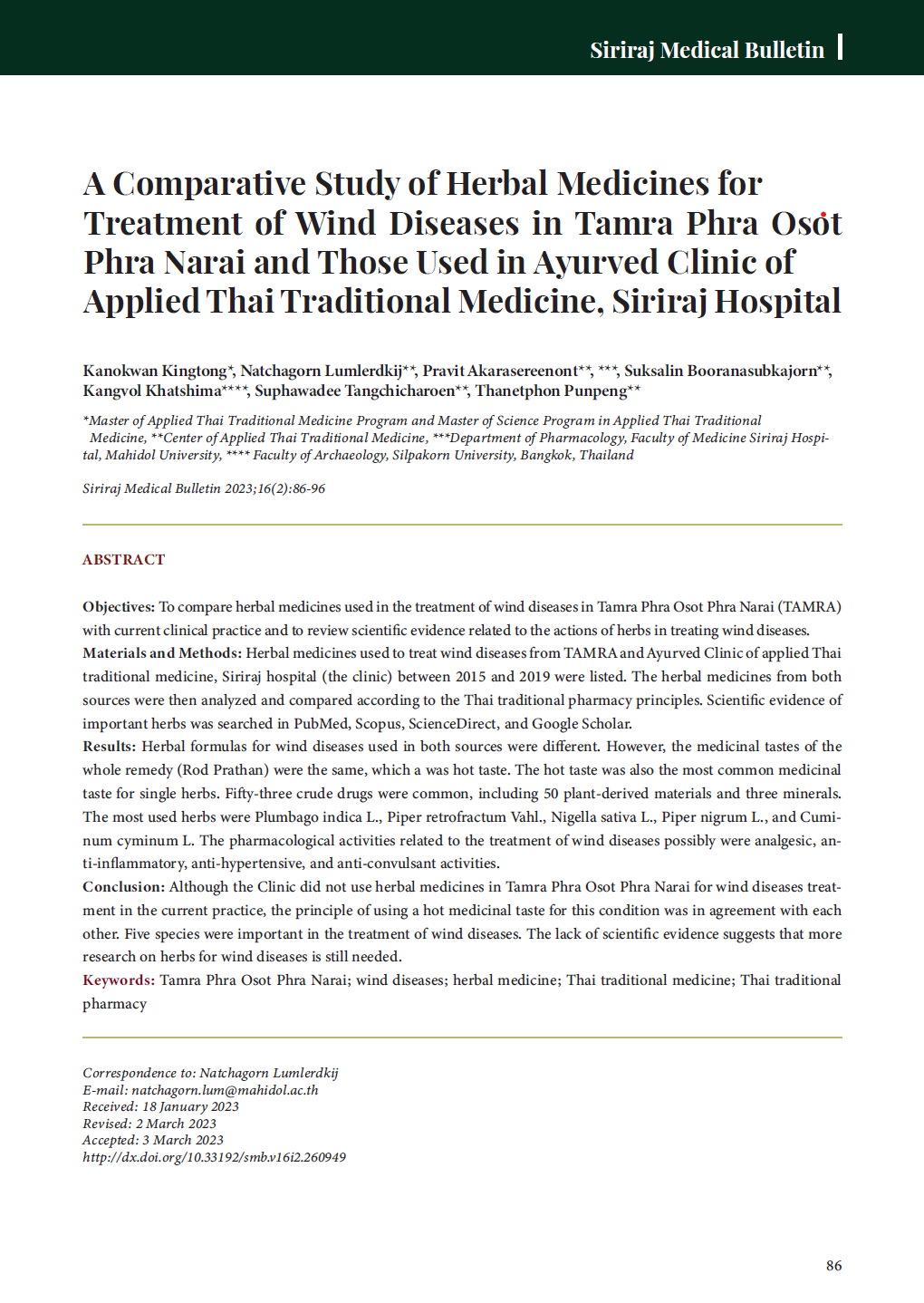A Comparative Study of Herbal Medicines for Treatment of Wind Diseases in Tamra Phra Osot Phra Narai and Those Used in Ayurved Clinic of Applied Thai Traditional Medicine, Siriraj Hospital
Main Article Content
Abstract
Objectives: To compare herbal medicines used in the treatment of wind diseases in Tamra Phra Osot Phra Narai (TAMRA) with current clinical practice and to review scientific evidence related to the actions of herbs in treating wind diseases.
Materials and Methods: Herbal medicines used to treat wind diseases from TAMRA and Ayurved Clinic of applied Thai traditional medicine, Siriraj hospital (the clinic) between 2015 and 2019 were listed. The herbal medicines from both sources were then analyzed and compared according to the Thai traditional pharmacy principles. Scientific evidence of important herbs was searched in PubMed, Scopus, ScienceDirect, and Google Scholar.
Results: Herbal formulas for wind diseases used in both sources were different. However, the medicinal tastes of the whole remedy (Rod Prathan) were the same, which a was hot taste. The hot taste was also the most common medicinal taste for single herbs. Fifty-three crude drugs were common, including 50 plant-derived materials and three minerals. The most used herbs were Plumbago indica L., Piper retrofractum Vahl., Nigella sativa L., Piper nigrum L., and Cuminum cyminum L. The pharmacological activities related to the treatment of wind diseases possibly were analgesic, anti-inflammatory, anti-hypertensive, and anti-convulsant activities.
Conclusion: Although the Clinic did not use herbal medicines in Tamra Phra Osot Phra Narai for wind diseases treatment in the current practice, the principle of using a hot medicinal taste for this condition was in agreement with each other. Five species were important in the treatment of wind diseases. The lack of scientific evidence suggests that more research on herbs for wind diseases is still needed.
Article Details

This work is licensed under a Creative Commons Attribution-NonCommercial-NoDerivatives 4.0 International License.
References
มูลนิธิฟื้นฟูส่งเสริมการแพทย์แผนไทยเดิมฯ และโรงเรียนอายุรเวทธำรง สถาบันการแพทย์แผนไทยประยุกต์ คณะแพทยศาสตร์ศิริราชพยาบาล มหาวิทยาลัยมหิดล. ตำราการแพทย์ไทยเดิม (แพทยศาสตร์สงเคราะห์ ฉบับอนุรักษ์). พิมพ์ครั้งที่ 3. กรุงเทพฯ: ศุภวนิชการพิมพ์; 2555.
ระบบคลังข้อมูลสุขภาพ [อินเทอร์เน็ต]. 2566 [เข้าถึงเมื่อ 1 มีนาคม 2566]. เข้าถึงได้จาก: https://hdcservice.moph.go.th/
ทวี เลาหพันธ์, เอื้อพงศ์ จตุรธำรง, ธานี เทพวัลย์. การแพทย์แผนไทยประยุกต์กับการพัฒนาการแพทย์แผนไทยให้ยั่งยืน ๒๕๕๔. พิมพ์ครั้งที่ 2. กรุงเทพฯ: สถานการแพทย์แผนไทยประยุกต์ คณะแพทยศาสตร์ศิริราชพยาบาล มหาวิทยาลัยมหิดล; 2554.
ทวี เลาหพันธ์, เอื้อพงศ์ จตุรธำรง. การแพทย์แผนไทยประยุกต์กับการพัฒนาการแพทย์แผนไทยให้ยั่งยืน ๒๕๕๕. พิมพ์ครั้งที่ 2. กรุงเทพฯ: สถานการแพทย์แผนไทยประยุกต์ คณะแพทยศาสตร์ศิริราชพยาบาล มหาวิทยาลัยมหิดล; 2555.
ชยันต์ พิเชียรสุนทร, แม้นมาส ชวลิต, วิเชียร จีรวงส์. คำอธิบายตำราพระโอสถพระนารายณ์ ฉบับเฉลิมพระเกียรติ 72 พรรษา มหาราช 5 ธันวาคม พุทธศักราช 2542. พิมพ์ครั้งที่ 3. กรุงเทพฯ: อมรินทร์พริ้นติ้งแอนด์พับลิชชิ่ง; 2558.
ชวน ศรสงคราม. ตำราพระโอสถพระนารายณ์. พระนคร: โรงพิมพ์ชวนพิมพ์ 112 ถนนบริพัตร; 2508.
เสงี่ยม พงษ์บุญรอด. ไม้เทศเมืองไทย สรรพคุณของยาเทศและยาไทย. กรุงเทพฯ: เกษมบรรณกิจ; 2522.
มูลนิธิฟื้นฟูส่งเสริมการแพทย์ไทยเดิม อายุรเวทวิทยาลัย (ชีวกโกมารภัจจ์). ตำราการเภสัชกรรม. กรุงเทพฯ: โรงพิมพ์อุษาการพิมพ์; 2559.
ธเนศพล พันธ์เพ็ง. การปรุงยาสมุนไพรตามกรรมวิธีทางการแพทย์แผนไทย 28 วิธี. กรุงเทพฯ: สำนักพิมพ์ศิริราช คณะแพทยศาสตร์ศิริราชพยาบาล มหาวิทยาลัยมหิดล; 2564.
Lumlerdkij N, Mamak C, Duangdamrong J, Phayakkhawisai T, Trakoolsilp B, Jamparngernthaweesri K, et al. Evaluation of Evidence Related to Medical Uses and Health Claims of Fingerroot. Siriraj Medical Bulletin. 2021;14(2):61-72.
Paul S, Saha D. Analgesic activity of methanol extract of Plumbago indica (L.) by acetic acid induced writhing method. Asian Journal of Pharmacy and Technology. 2012;2(2):74-6.
Ittiyavirah S, Jobin K, Jissa M, Jomy M, Josmi T, Littin B. ANTI-INFLAMMATORY AND ANALGESIC ACTIVITIES OF PLUMBAGO CAPENSIS AND PLUMBAGO INDICA. Advances in Pharmacology & Toxicology. 2012;13(1).
Sireeratawong S, Itharat A, Lerdvuthisopon N, Piyabhan P, Khonsung P, Boonraeng S, et al. Anti-Inflammatory, Analgesic, and Antipyretic Activities of the Ethanol Extract of Piper interruptum Opiz. and Piper chaba Linn. International Scholarly Research Notices. 2012;2012.
Mohtashami R, Huseini HF, Heydari M, Amini M, Sadeqhi Z, Ghaznavi H, et al. Efficacy and safety of honey based formulation of Nigella sativa seed oil in functional dyspepsia: A double blind randomized controlled clinical trial. Journal of ethnopharmacology. 2015;175:147-52.
Enayatfard L, Mohebbati R, Niazmand S, Hosseini M, Shafei MN. The standardized extract of Nigella sativa and its major ingredient, thymoquinone, ameliorates angiotensin II-induced hypertension in rats. Journal of basic and clinical physiology and pharmacology. 2019;30(1):51-8.
Fallah Huseini H, Amini M, Mohtashami R, Ghamarchehre M, Sadeqhi Z, Kianbakht S, et al. Blood pressure lowering effect of Nigella sativa L. seed oil in healthy volunteers: A randomized, double-blind, placebo-controlled clinical trial. Phytotherapy Research. 2013;27(12):1849-53.
Tuna HI, Babadag B, Ozkaraman A, Alparslan GB. Investigation of the effect of black cumin oil on pain in osteoarthritis geriatric individuals. Complementary therapies in clinical practice. 2018;31:290-4.
Islam MH, Ahmad IZ, Salman MT. In vivo Evaluation of Anti-inflammatory and Analgesic activities of Nigella sativa seed during germination. Int J Pharm Pharm Sci. 2013;5(4):451-4.
Bukhari I, Alhumayyd M, Mahesar A, Gilani A. The analgesic and anticonvulsant effects of piperine in mice. Journal of Physiology and Pharmacology. 2013;64(6):789.
Tasleem F, Azhar I, Ali SN, Perveen S, Mahmood ZA. Analgesic and anti-inflammatory activities of Piper nigrum L. Asian Pacific journal of tropical medicine. 2014;7:S461-S8.
Costa R, Machado J, Abreu C. Evaluation of analgesic properties of piper nigrum essential oil: a randomized, double-blind, placebo-controlled study. World Journal of Traditional Chinese Medicine. 2016;2(2):60.
Ebihara T, Ebihara S, Maruyama M, Kobayashi M, Itou A, Arai H, et al. A randomized trial of olfactory stimulation using black pepper oil in older people with swallowing dysfunction. Journal of the American Geriatrics Society. 2006;54(9):1401-6.
Bhat SP, Rizvi W, Kumar A. Effect of Cuminum cyminum L. seed extracts on pain and inflammation. Journal of Natural Remedies. 2014;14(2):186-92.
สถาบันการแพทย์แผนไทย กรมพัฒนาการแพทย์แผนไทยและการแพทย์ทางเลือก กระทรวงสาธารณสุข. บัญชีจำแนกโรคระหว่างประเทศฉบับประเทศไทย บัญชีรหัสกลุ่มโรค อาการและหัตถการด้านการแพทย์แผนไทย. นนทบุรี: สำนักกิจการโรงพิมพ์ องค์การสงเคราะห์ทหารผ่านศึกในพระบรมราชูปถัมภ์; 2558.
สํานักงานคณะกรรมการอาหารและยา. ประกาศสํานกงานคณะกรรมการอาหารและยา เรื่อง แก้ไขทะเบียนตํารับยาที่มีไคร้เครือเป็นส่วนประกอบ [อินเทอร์เน็ต]. 2556 [เข้าถึงเมื่อ 12 ตุลาคม 2564]. เข้าถึงได้จาก: http://www.ratchakitcha.soc.go.th/DATA/PDF/2556/E/049/55.PDF.
กระทรวงเกษตรและสหกรณ์. ประกาศกระทรวงเกษตรและสหกรณ์ เรื่อง พืชอนุรักษ์ พ.ศ. ๒๕๖๔ [อินเทอร์เน็ต]. 2564 [เข้าถึงเมื่อ24 กุมภาพันธ์ 2566]. เข้าถึงได้จาก: http://www.doa.go.th/pvp/wp-content/uploads/2021/07/ประกาศพืชอนุรักษ์-2564.pdf.






